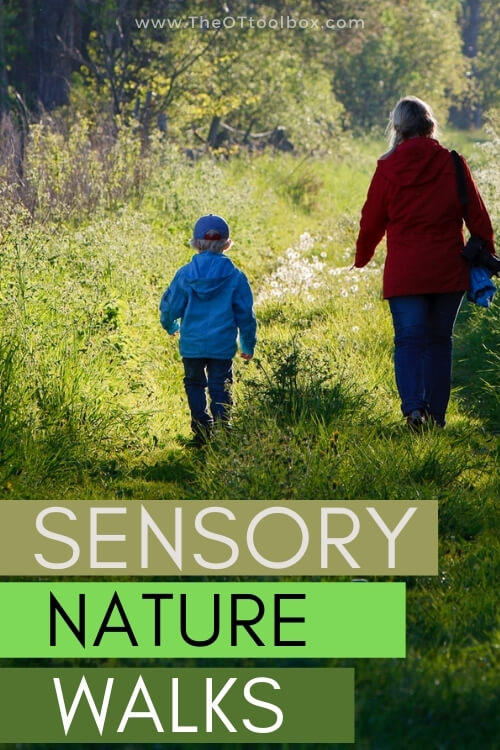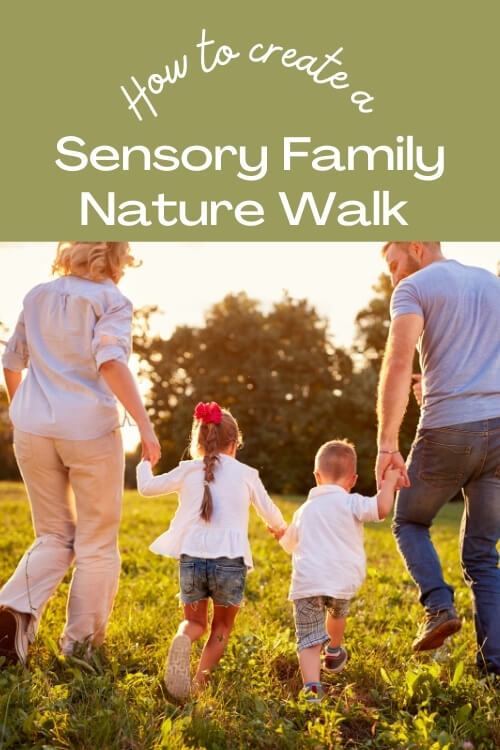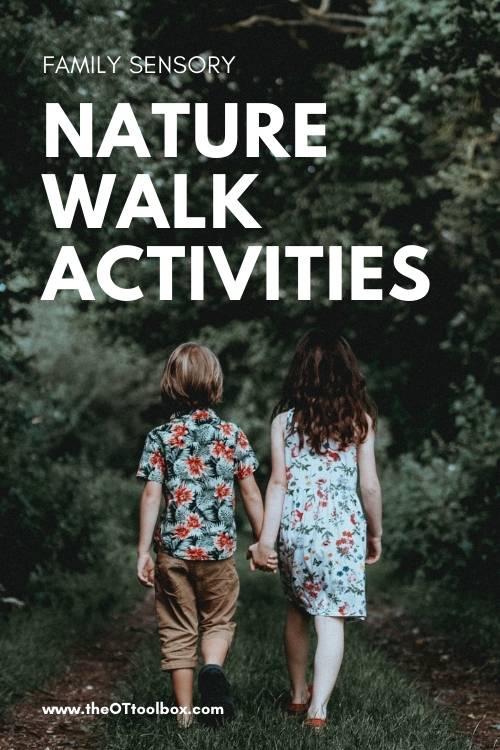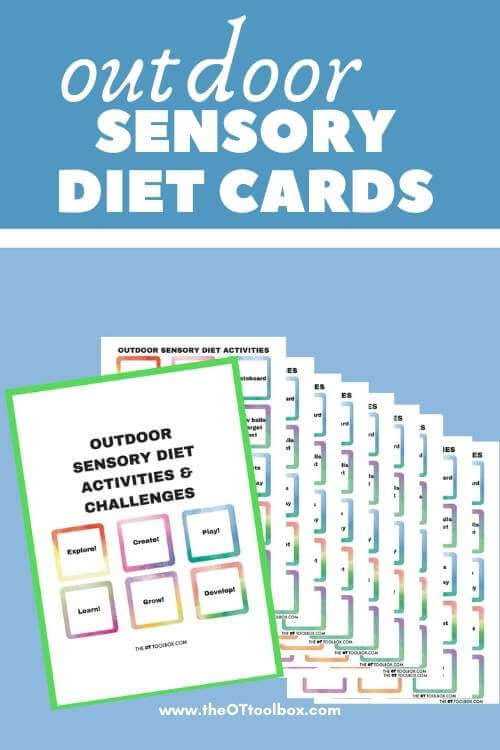There are so many benefits to getting the whole family out for a family nature walk. Besides the physical exercise and family time, nature walks are powerful tools to incorporate all of the senses without any sensory equipment. Research tells us outdoor sensory play has many benefits. Use the sensory activities described here to learn and explore all of the senses (including the proprioceptive, vestibular, and interoceptive senses!) and add these sensory nature walk ideas to an outdoor sensory diet to help kids achieve an optimal sensory state so they can complete functional tasks and daily occupations.

Nature Walk Sensory Benefits
A nature walk and all of its colors, sights, and sounds make for a multi-sensory experience that can be easily shared as a family. There are so many sensory benefits when going on a nature walk or simply just by getting outdoors. The sensory input, learning and development, and simple family connection are just a few long-term benefits that can be provided by hiking in the woods.
Nature walks promote wellness by meeting many different needs:
- Physical exercise and physical activity
- Relaxation
- Establishment of healthy habits in kids
- Emotional management
- Mindfulness
- Facilitate engagement and an alert state of regulation
- Learning and cognitive benefits
- Play and activity
- Social interaction
- Rest and sleep
All of these benefits make a family nature walk perfect for a family fun day! Or, pull out the flashlights and headlamps and go on a night walk as part of a family fun night.

Sensory Nature Walk
Stimulating the senses can help a child reconnect with their inner self, helping them identify how their body calms and relates to a free-flowing natural environment. Parents can help facilitate a child’s interaction in nature and the outdoors by simply being aware of a few activities that can be enjoyed as a family while experiencing the outdoors. Every sense can be utilized and engaged with a few fun ideas.
To help get you started, take look at the sensory components of a nature walk:
Nature Walks and the Visual Sense
The visual (sight) sense can be stirred by the abundance of colors with the trees and leaves and don’t forget to take some time to seek out a few outdoor critters or insects which can add a little element of fun while observing.
Try these visual processing activities during a family nature walk:
- Play a game of I-Spy during your outdoor adventure. Think about playing using colors or items found in the environment. Take turns, and work on building vocabulary while playing this game.
- Do a scavenger hunt and look for certain things found in the woods (you can find printable nature scavenger hunts on the internet).
- Complete some nature rubbings with paper and crayons. Maybe rub some leaves within a notebook or complete rubbings of different types of tree bark.
- Take a notebook and write down items you see in nature. It can be a nature journal that adds an opportunity to work on handwriting.
Auditory Processing and Sensory Walks
The auditory (hearing) sense can be jostled by the crunching of leaves under the feet as well as the snapping of twigs that can be heard while walking along a path or in the woods.
- Snap twigs and listed to the cracks. Maybe even taking some time to build a few fun critter forts allowing for snapping of twigs to measure and build.
- Also, try snapping twigs and building letters to add a little handwriting into the nature walk.
- Listen for the birds and their chirping of songs and listen for some rustling of leaves when squirrels and other critters move about the woods.
- Maybe the breeze is blowing, is it causing the trees and leaves to sway back and forth? Close your eyes and simply just listen to hear (it adds another fun element).
Gustatory Sense and Family Walks
The gustatory (taste) sense can be provided a little nudge, with adult supervision of course, if you find some wild blackberries or strawberries. They can be yummy to eat, but they do require cleaning so you may want to wait until you get back home to eat them so they can be properly cleaned for complete safety. If you are not that adventurous though, that’s okay you can still stimulate the gustatory sense on your walk if you work to prepare a fun trail mix before you leave the house so you can eat it on your outdoor adventure.
- Bring a cold drink- A water bottle can be added to a backpack and brought along for a cold drink during a family walk. Remember the proprioceptive and oral motor benefits to drinking through a sports bottle, or a straw in a water bottle with a straw lid.
- Nature walk snacks-Don’t have time to make trail mix, that’s okay too, you can just grab some granola or granola bars or maybe even some veggie sticks or beef jerky!
Tactile Sensory Nature Walk
The tactile (touch) sense can be heavily engaged with all of the different textures that can be explored and possibly gathered on your nature walk. Try some of these strategies on your nature walk:
- Take some time to feel the leaves, moss, tree bark, rocks, dirt, and even a few fuzzy critters that can be given a little lift to their next destination.
- Tossing rocks into small streams or even walking through puddles of water could provide a multi-sensory experience.
- Write a few letters in the dirt with use of broken twigs as a pencil.
- Take some time to feel the warmth of the sun or the breeze on your face as you walk.
- Be sure to collect some nature items along the way though so you can explore them later either in a sensory bin or in an art project.
- Find and count nature items in an egg carton.
- Play toss and catch with pine cones as appropriate. Toss and catch to each other or have kiddos toss to themselves including back and forth between their left and right hands.
- Stick nature items to contact paper while on a nature walk.
Olfactory sense and family sensory walks
The olfactory (smell) sense can be triggered by taking time to smell the dried leaves, flower scents, and even the smells that get blown as the wind or breeze lifts them through the air. Let’s face it, the wilderness has many smells that are unidentified and when mixed together create scents that are unusual kind of, musty. Even decaying wood has a very unique smell. Try these olfactory activities:
- Smell flowers
- Close your eyes and smell the air. Can you identify any scents?
- Talk about scent words and the meaning of those terms. Some concepts to explore are: fresh, musty, moldy, sweet, sour, dry, etc.
Proprioception and Nature Walks
The proprioceptive (muscles and joints) sense can be impacted if you allow the child to lift heavy rocks, larger limbs and even just jump from higher elevations such as large rocks. All of the walking, climbing, and exploring adds heavy work input that tells the body where it is in space so the legs and body as a whole can move. Heavy work is a calming and regulating source of getting to a calm and alert state. Consider these opportunities for adding proprioceptive input on a nature walk:
- Allow them to climb some trees and hillsides.
- Explore trails with variations on elevation.
- Consider the walking surface. Walking through a field, even trail, flat trail, or wooded hiking trail, or paved sidewalk offer different variants of heavy work though the legs and core.
- Add hopping, jumping, bending, leaping, galloping, or skipping as you walk.
- Even just the act of walking up and down the trail inclines can provide muscle and joint input that can be regulating for some kiddos.
- Carrying water bottles in a backpack is an additional opportunity for heavy work.
Nature walks and the Vestibular sense
The vestibular (movement) sense can be activated as a child moves their body around the trees and rocks even while crawling up large rocks and trees. Incorporate vestibular input through these ideas:
- Have them try some simple spinning with their eyes open and closed and arms outstretched to get a unique view of the outdoors maybe even doing some somersaults or cartwheels.
- Allow them to try out their balance skills as they walk across a downed tree or along a trail of rocks.
- Climb trees.
- Run up hills.
- Roll down grassy hills.
Nature walks and interoception
The interoception (inner body awareness) sense can be explored by the act of simply disconnecting from technology and other distractions and identifying how the body feels during this change of setting and heavy multi-sensory environment. An additional benefit of family walks is the connection to sleep (described more in detail at the bottom of this post.) Sleep has been noted to be included in the interoceptive processes much like hunger or thirst, as a brain process similar to other homeostatic processes.
Incorporate interoception in nature with these strategies:
- Work on identifying their feelings and bodily responses to the sensory input such as noticing their breathing, heart rate, temperature, or possibly if they feel either tired, hungry, or thirsty.
- How do you feel? A walk can change how you’re feeling. Maybe you feel re-energized and more alert. Talk about it.
- Mindfulness is impacted by nature. Take deep breaths. Can you feel your heart rate slowing down?
- Thirst inventory- How do you feel after a hike in nature? Thirsty? Dry mouth? These are signs that your body is thirsty. Some people struggle with this internal awareness. Talk about the signs of thirst and how the body reacts to this need and then afterwards once you’ve got a drink.

Nature Walk Activities
A nature walk is a fun time to collect items from nature for exploring. While out on family walk, collect items from nature such as rocks, pebbles, sticks, leaves, moss, etc. These items can be placed into a backpack or bag and brought home to explore and create. (Be sure to return items to nature, afterwards as long as they are free from paint or glue.)
After you’ve finished your outdoor adventure and you’ve collected some fun nature goodies from your walk, take those items home and create a sensory bin, fine motor craft kit, or maybe even use them in a fun art project. What can you collect?
Look for some of these items (and explore the visual sense as you seek and find items):
- Acorns
- Twigs
- Leaves
- Rocks
- Feathers
- Pine needles
- Pine cones
- Moss
- Seeds
- Grasses
- Sand
- Dirt
- Sunflower seeds
- Fallen tree bark
Nature Walk Sensory Bins
Use these materials to make a sensory bin. Add the items you’ve collected to a large bin, basket, or tray. Now it’s time to explore! Try these nature sensory bin ideas:
- Wash rocks sensory play
- Make a calming nature sensory bottle
- Sand and sticks sensory bin
- Dandelion sensory bin
- Nature Play Dough Press
- Nature Water Table
Nature Walk Art Projects
The nature items collected on a family walk can be used to make art, too. Incorporate some added art supplies to get started:
- Paint
- Paint brush
- Playdough
- Beans/Peas
- Glue
- String
- Paper/paste or cardboard
- Googly eyes
- Chenille stems
- Egg cartons
- Contact paper
Then, try these nature art projects that help to develop motor skills, fine motor strength, coordination, motor planning, and more:
- Make letters and words with sticks
- Clay nature sculptures
- Use nature to make a flower craft
- Count and sort nature items in an egg carton
- Stick nature items to contact paper
- Paint rocks
Sensory Nature Walks and Rest
An added benefit of incorporating a nature walk into the family routine is that walks in turn promote rest. All of the physical activity of nature walks may be helpful in encouraging rest and as a result, sleep.
Additionally, research suggests a relationship between sleep difficulties and patterns of sensory processing issues in children.
Studies show that sensory processing differences, considerably including increased sensory sensitivities, sensory-avoiding patterns, sensory-seeking patterns, and poor sensory registration have been associated with changes in sleep quality. (Vasek, M., Williamson, J., Garden, J., Zwicker, J., 2015).
Occupational therapists play a role in sleep by offering tools and strategies to promote adequate and restful sleep. Because sleep is a necessary component of performing functional tasks and daily occupations, occupational therapists can assist with promoting adequate and healthy sleep by using evidence based methods, once of which can include physical activity such as family nature walks.
A final note about sensory walks
Take a seasonal nature walk to simply allow children to explore with their senses while building skills needed for learning and development! Allow children the freedom to explore at their own pace and to be creative. Give them the opportunity to come up with a fun, family activity outdoors. They’ll surprise you!
Don’t live near a colorful hiking area? Take some time to visit a farm, a pumpkin patch, a flower garden, a cornfield, or even the beach. Really, just get outdoors and explore anywhere! By being outside away from technology and other distractions, children can rejuvenate their bodies and minds while stimulating their senses.
Try these resources to incorporate the sensory system when in the great outdoors:
Outdoor Sensory Diet Activities
Outdoor Sensory Diet Activities in the Backyard
Outdoor Recess Sensory Diet Activities
Sensory Diet Activities at the Playground
Sensory Processing at the Playground
Add the Outdoor Sensory Diet Cards to your therapy toolbox:
Create the “right kind” of sensory experiences to improve regulation, attention, focus, body awareness, motor development, and sensory processing.
- 90 outdoor sensory diet activities
- 60 outdoor recess sensory diet activities
- 30 blank sensory diet cards, and 6 sensory challenge cards
- They can be used based on preference and interest of the child, encouraging motivation and carryover, all while providing much-needed sensory input.
References:
Mark Vasak, James Williamson, Jennifer Garden, Jill G. Zwicker; Sensory Processing and Sleep in Typically Developing Infants and Toddlers. Am J Occup Ther 2015;69(4):6904220040. https://doi.org/10.5014/ajot.2015.015891

Regina Parsons-Allen is a school-based certified occupational therapy assistant. She has a pediatrics practice area of emphasis from the NBCOT. She graduated from the OTA program at Caldwell Community College and Technical Institute in Hudson, North Carolina with an A.A.S degree in occupational therapy assistant. She has been practicing occupational therapy in the same school district for 20 years. She loves her children, husband, OT, working with children and teaching Sunday school. She is passionate about engaging, empowering, and enabling children to reach their maximum potential in ALL of their occupations as well assuring them that God loves them!







